sensor TOYOTA SUPRA 2020 (in English) Owner's Guide
[x] Cancel search | Manufacturer: TOYOTA, Model Year: 2020, Model line: SUPRA, Model: TOYOTA SUPRA 2020Pages: 356, PDF Size: 6.04 MB
Page 220 of 356
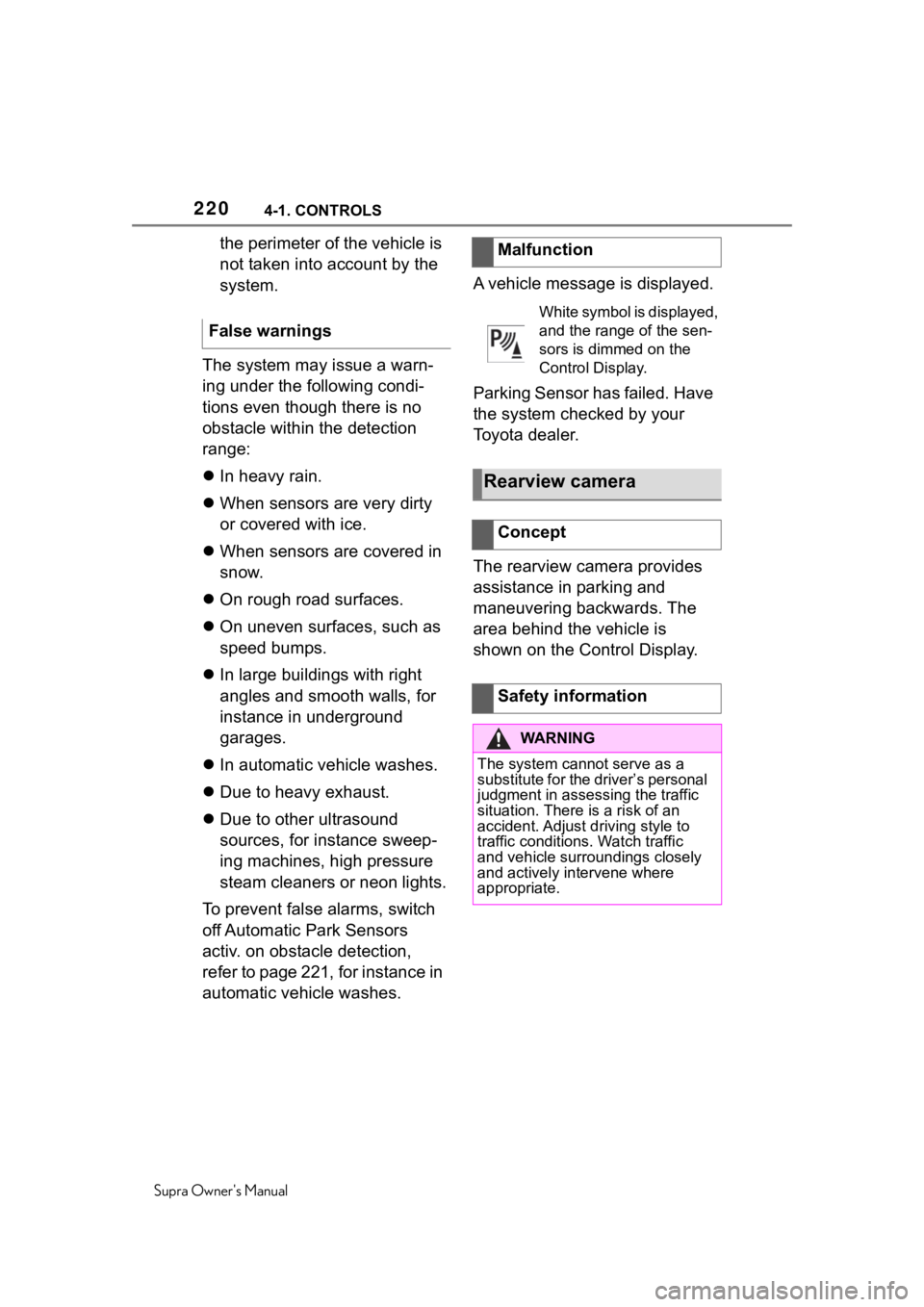
2204-1. CONTROLS
Supra Owner's Manual
the perimeter of the vehicle is
not taken into account by the
system.
The system may issue a warn-
ing under the following condi-
tions even though there is no
obstacle within the detection
range:
In heavy rain.
When sensors are very dirty
or covered with ice.
When sensors are covered in
snow.
On rough road surfaces.
On uneven surfaces, such as
speed bumps.
In large buildings with right
angles and smooth walls, for
instance in underground
garages.
In automatic vehicle washes.
Due to heavy exhaust.
Due to other ultrasound
sources, for instance sweep-
ing machines, high pressure
steam cleaners or neon lights.
To prevent false alarms, switch
off Automatic Park Sensors
activ. on obstacle detection,
refer to page 221, for instance in
automatic vehicle washes. A vehicle message is displayed.
Parking Sensor has failed. Have
the system checked by your
Toyota dealer.
The rearview camera provides
assistance in parking and
maneuvering backwards. The
area behind the vehicle is
shown on the Control Display.
False warningsMalfunction
White symbol is displayed,
and the range of the sen-
sors is dimmed on the
Control Display.
Rearview camera
Concept
Safety information
WA R N I N G
The system cannot serve as a
substitute for the driver’s personal
judgment in assessing the traffic
situation. There is a risk of an
accident. Adjust d
riving style to
traffic conditions. Watch traffic
and vehicle surroundings closely
and actively intervene where
appropriate.
Page 222 of 356

2224-1. CONTROLS
Supra Owner's Manual
switched on.
The trunk lid is fully closed.
Keep the recording range of
the camera clear. Protruding
cargo or carrier systems that
are not connected to a trailer
power socket can restrict the
visibility range of the camera.
More than one assistance func-
tion can be active at the same
time.
The assistance functions can be
manually activated.
1 Move the Controller to the
right, if needed.
2 With corresponding equip-
ment:
3 With corresponding equip-
ment: "Camera image"
"Parking aid lines".
Pathway lines and turning radius
lines are displayed, refer to page
222.
"Obstacle marking".
Depending on the vehicle equip-
ment, the obstacles detected by
Parking Sensors are displayed,
refer to page
223, by markings.
■Pathway lines
Pathway lines help you to esti-
mate the space required when
parking and maneuvering on
level roads.
Pathway lines depend on the
steering angle and are continu-
ously adjusted to the steering
wheel movements.
■Turning radius lines
Turning radius lines can only be
superimposed on the camera
image together with pathway
lines.
Turning radius lines show the
course of the smallest possible
turning radius on a level road.
Only one turning radius line is
displayed after the steering
Assistance functions
General information
Parking aid lines
Page 223 of 356
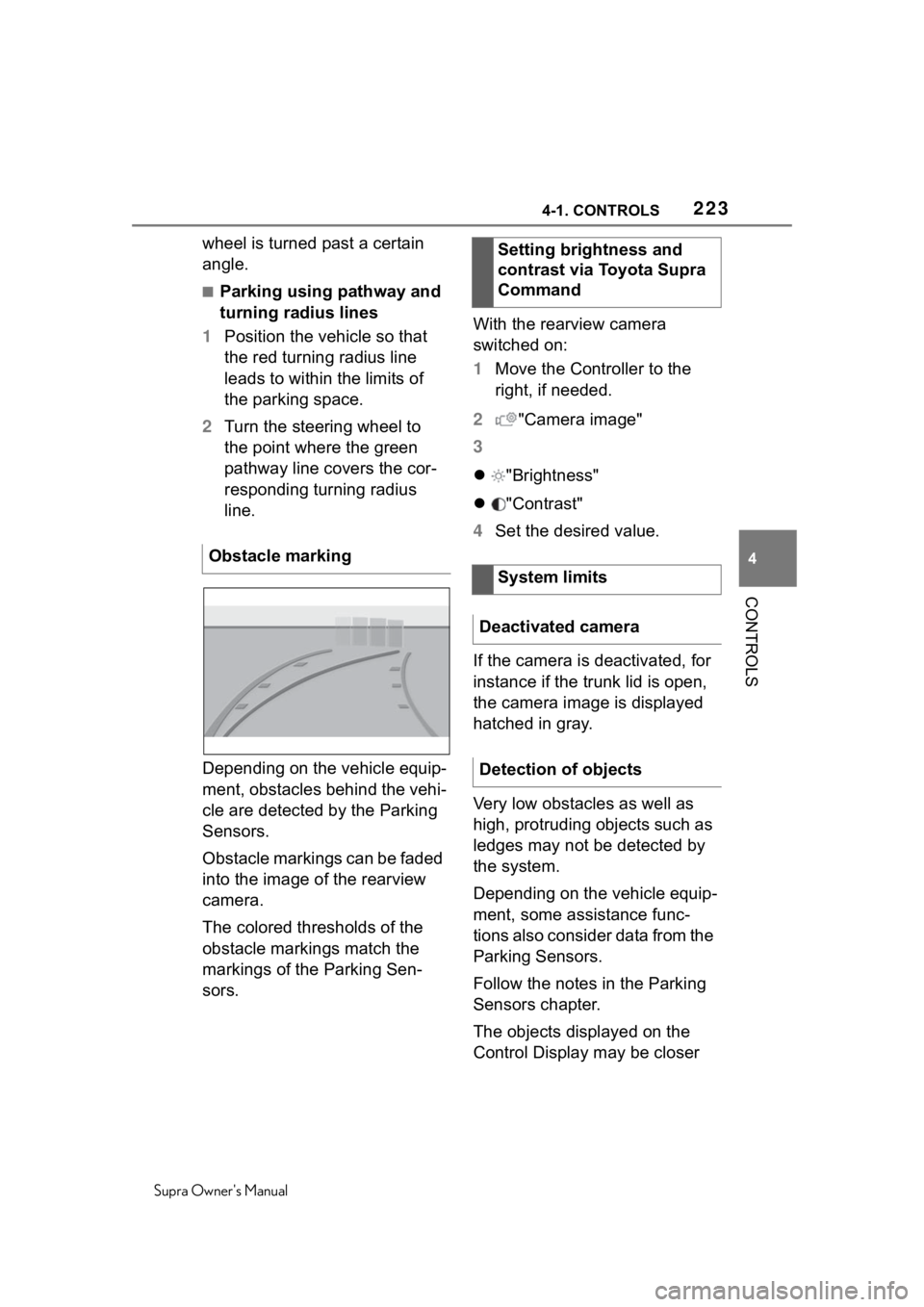
2234-1. CONTROLS
Supra Owner's Manual
4
CONTROLS
wheel is turned past a certain
angle.
■Parking using pathway and
turning radius lines
1 Position the vehicle so that
the red turning radius line
leads to within the limits of
the parking space.
2 Turn the steering wheel to
the point where the green
pathway line covers the cor-
responding turning radius
line.
Depending on the vehicle equip-
ment, obstacles behind the vehi-
cle are detected by the Parking
Sensors.
Obstacle markings can be faded
into the image of the rearview
camera.
The colored thresholds of the
obstacle markings match the
markings of the Parking Sen-
sors. With the rearview camera
switched on:
1
Move the Controller to the
right, if needed.
2 "Camera image"
3
"Brightness"
"Contrast"
4 Set the desired value.
If the camera is deactivated, for
instance if the trunk lid is open,
the camera image is displayed
hatched in gray.
Very low obstacles as well as
high, protruding objects such as
ledges may not be detected by
the system.
Depending on the vehicle equip-
ment, some assistance func-
tions also consider data from the
Parking Sensors.
Follow the notes in the Parking
Sensors chapter.
The objects displayed on the
Control Display may be closer
Obstacle marking
Setting brightness and
contrast via Toyota Supra
Command
System limits
Deactivated camera
Detection of objects
Page 224 of 356

2244-1. CONTROLS
Supra Owner's Manual
than they appear. Do not esti-
mate the distance from the
objects on the display.
At blind driveways or when driv-
ing out of diagonal parking
spaces, approaching cross traf-
fic is detected sooner by the
system than is possible from the
driver's seat.
Two radar sensors in the rear
bumper monitor the area behind
the vehicle.
The system indicates approach-
ing traffic.The radar sensors are located in
the rear bumper.
Always keep the bumper in the
RCTA (Rear cross traffic
alert) function
Concept
General information
Safety information
WA R N I N G
The system cannot serve as a
substitute for the driver’s personal
judgment in assessing visibility
and traffic situation. There is a risk
of an accident. Adjust driving style
to traffic conditions. Watch traffic
closely and actively intervene
where appropriate.
Overview
Button in the vehicle
Park assistance button
Radar sensors
Page 225 of 356
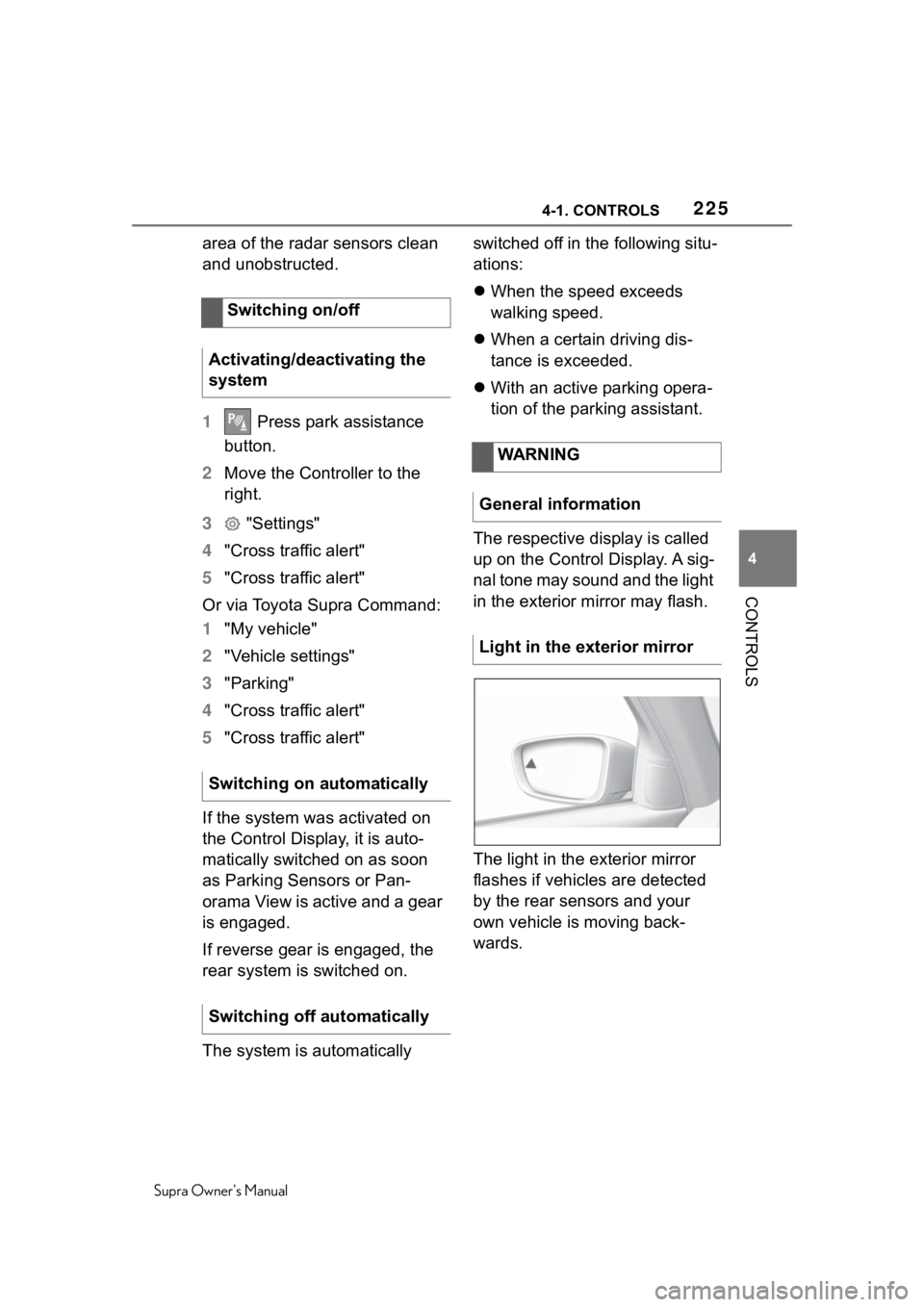
2254-1. CONTROLS
Supra Owner's Manual
4
CONTROLS
area of the radar sensors clean
and unobstructed.
1 Press park assistance
button.
2 Move the Controller to the
right.
3 "Settings"
4 "Cross traffic alert"
5 "Cross traffic alert"
Or via Toyota Supra Command:
1 "My vehicle"
2 "Vehicle settings"
3 "Parking"
4 "Cross traffic alert"
5 "Cross traffic alert"
If the system was activated on
the Control Display, it is auto-
matically switched on as soon
as Parking Sensors or Pan-
orama View is active and a gear
is engaged.
If reverse gear is engaged, the
rear system is switched on.
The system is automatically switched off in the following situ-
ations:
When the speed exceeds
walking speed.
When a certain driving dis-
tance is exceeded.
With an active parking opera-
tion of the parking assistant.
The respective display is called
up on the Control Display. A sig-
nal tone may sound and the light
in the exterior mirror may flash.
The light in the exterior mirror
flashes if vehicles are detected
by the rear sensors and your
own vehicle is moving back-
wards.
Switching on/off
Activating/deactivating the
system
Switching on automatically
Switching off automatically
WARNING
General information
Light in the exterior mirror
Page 226 of 356
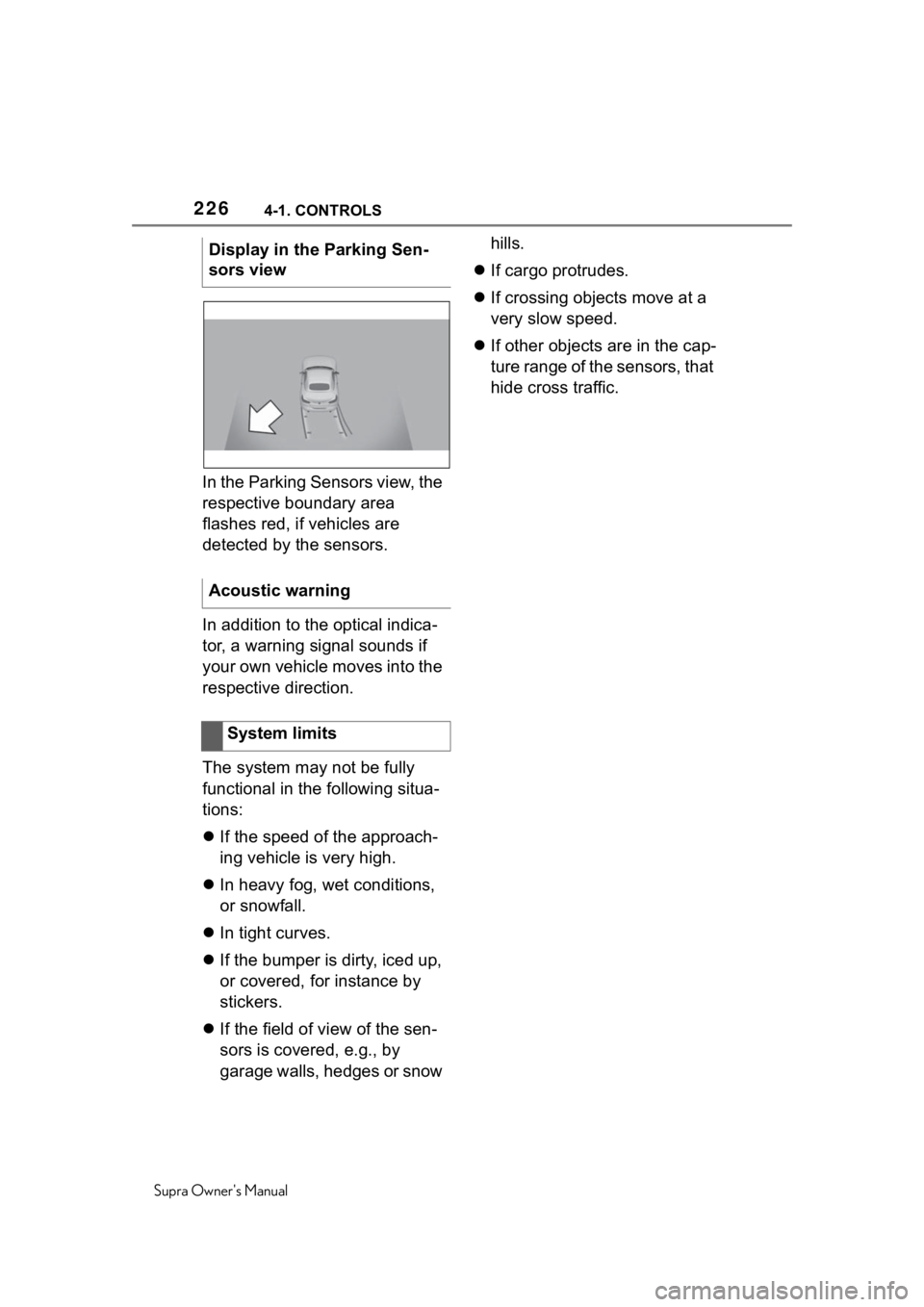
2264-1. CONTROLS
Supra Owner's Manual
In the Parking Sensors view, the
respective boundary area
flashes red, if vehicles are
detected by the sensors.
In addition to the optical indica-
tor, a warning signal sounds if
your own vehicle moves into the
respective direction.
The system may not be fully
functional in the following situa-
tions:
If the speed of the approach-
ing vehicle is very high.
In heavy fog, wet conditions,
or snowfall.
In tight curves.
If the bumper is dirty, iced up,
or covered, for instance by
stickers.
If the field of view of the sen-
sors is covered, e.g., by
garage walls, hedges or snow hills.
If cargo protrudes.
If crossing objects move at a
very slow speed.
If other objects are in the cap-
ture range of the sensors, that
hide cross traffic.
Display in the Parking Sen-
sors view
Acoustic warning
System limits
Page 231 of 356
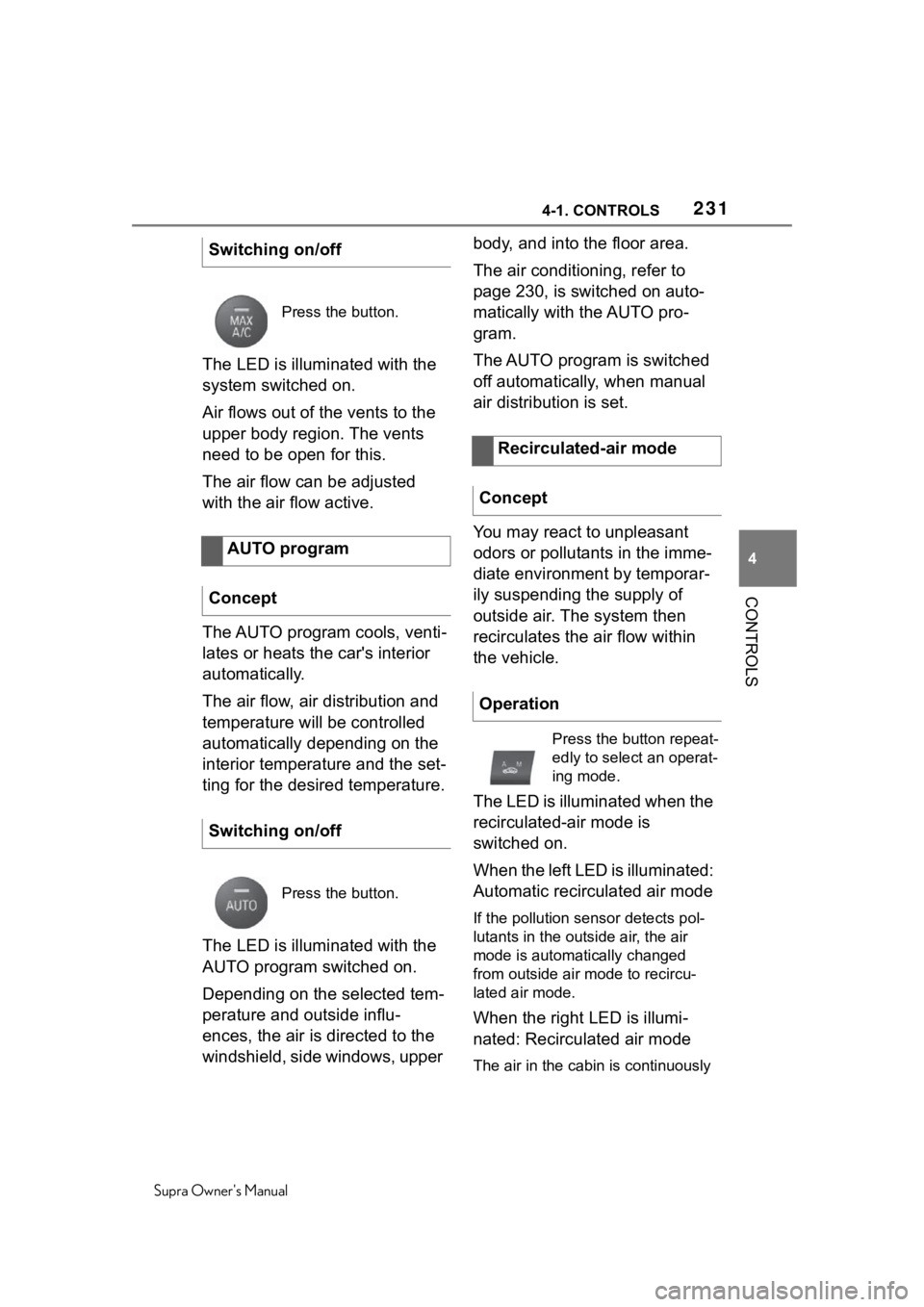
2314-1. CONTROLS
Supra Owner's Manual
4
CONTROLS
The LED is illuminated with the
system switched on.
Air flows out of the vents to the
upper body region. The vents
need to be open for this.
The air flow can be adjusted
with the air flow active.
The AUTO program cools, venti-
lates or heats the car's interior
automatically.
The air flow, air distribution and
temperature will be controlled
automatically depending on the
interior temperature and the set-
ting for the desired temperature.
The LED is illuminated with the
AUTO program switched on.
Depending on the selected tem-
perature and outside influ-
ences, the air is directed to the
windshield, side windows, upper body, and into the floor area.
The air conditioning, refer to
page 230, is switched on auto-
matically with the AUTO pro-
gram.
The AUTO program is switched
off automatically, when manual
air distribution is set.
You may react to unpleasant
odors or pollutants in the imme-
diate environment by temporar-
ily suspending the supply of
outside air. The system then
recirculates the air flow within
the vehicle.
The LED is illuminated when the
recirculated-air mode is
switched on.
When the left LED is illuminated:
Automatic recirculated air mode
If the pollution sensor detects pol-
lutants in the outside air, the air
mode is automatically changed
from outside air mode to recircu-
lated air mode.
When the right LED is illumi-
nated: Recirculated air mode
The air in the cabin is continuously
Switching on/off
Press the button.
AUTO program
Concept
Switching on/off
Press the button.
Recirculated-air mode
Concept
Operation
Press the button repeat-
edly to select an operat-
ing mode.
Page 278 of 356
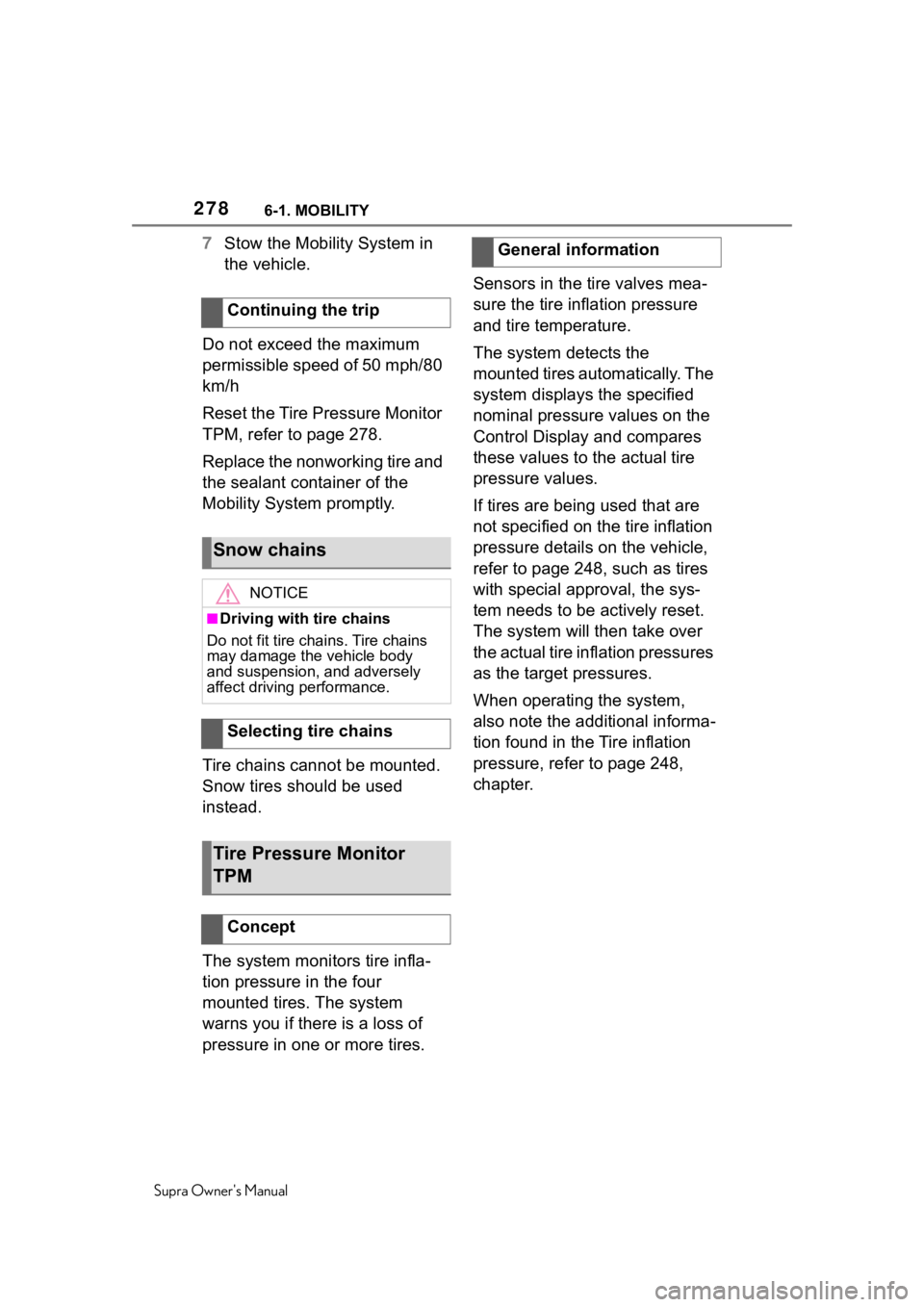
2786-1. MOBILITY
Supra Owner's Manual
7Stow the Mobility System in
the vehicle.
Do not exceed the maximum
permissible speed of 50 mph/80
km/h
Reset the Tire Pressure Monitor
TPM, refer to page 278.
Replace the nonworking tire and
the sealant container of the
Mobility System promptly.
Tire chains cannot be mounted.
Snow tires should be used
instead.
The system monitors tire infla-
tion pressure in the four
mounted tires. The system
warns you if there is a loss of
pressure in one or more tires. Sensors in the tire valves mea-
sure the tire inflation pressure
and tire temperature.
The system detects the
mounted tires automatically. The
system displays the specified
nominal pressure values on the
Control Display and compares
these values to the actual tire
pressure values.
If tires are being used that are
not specified on the tire inflation
pressure details on the vehicle,
refer to page 248, such as tires
with special approval, the sys-
tem needs to be actively reset.
The system will then take over
the actual tire inflation pressures
as the target pressures.
When operating the system,
also note the additional informa-
tion found in the Tire inflation
pressure, refer to page 248,
chapter.
Continuing the trip
Snow chains
NOTICE
■Driving with tire chains
Do not fit tire chains. Tire chains
may damage the vehicle body
and suspension, and adversely
affect driving performance.
Selecting tire chains
Tire Pressure Monitor
TPM
Concept
General information
Page 300 of 356

3006-1. MOBILITY
Supra Owner's Manual
Sensors and special algorithms
take into account the driving
conditions of the vehicle. CBS
uses these to calculate the need
for maintenance.
The system makes it possible to
adapt the amount of mainte-
nance corresponding to your
user profile.
Information on service require-
ments, refer to page 141, can be
displayed on the Control Dis-
play.
Storage periods during which
the vehicle battery was discon-
nected are not taken into
account.
If this occurs, have a Toyota
dealer update the time-depen-
dent maintenance procedures,
such as checking brake fluid
and, if necessary, changing the
engine oil and the microfil-
ter/activated-charcoal filter.Please consult your "Owner's
Warranty Information Booklet"
or "Owner's Manual Supple-
ment" for additional information
on service requirements.
The manufacturer of your vehi-
cle recommends that mainte-
nance and repair be performed
by a Toyota dealer. Records of
regular maintenance and repair
work should be retained.
Scheduled maintenance should
be performed at specified inter-
vals according to the mainte-
nance schedule.
For details about maintenance
items and schedules, refer to
the "Scheduled Maintenance
Guide" or "Owner's Manual Sup-
plement".
Devices connected to the OBD
socket trigger the alarm system
when the vehicle is locked.
Remove any devices con-
nected at the OBD socket
Condition Based Service
CBS
Concept
General information
Storage periods
"Owner's Warranty Infor-
mation Booklet" or
"Owner's Manual Supple-
ment"
Scheduled maintenance
Socket for OBD Onboard
Diagnosis
General information
Page 320 of 356
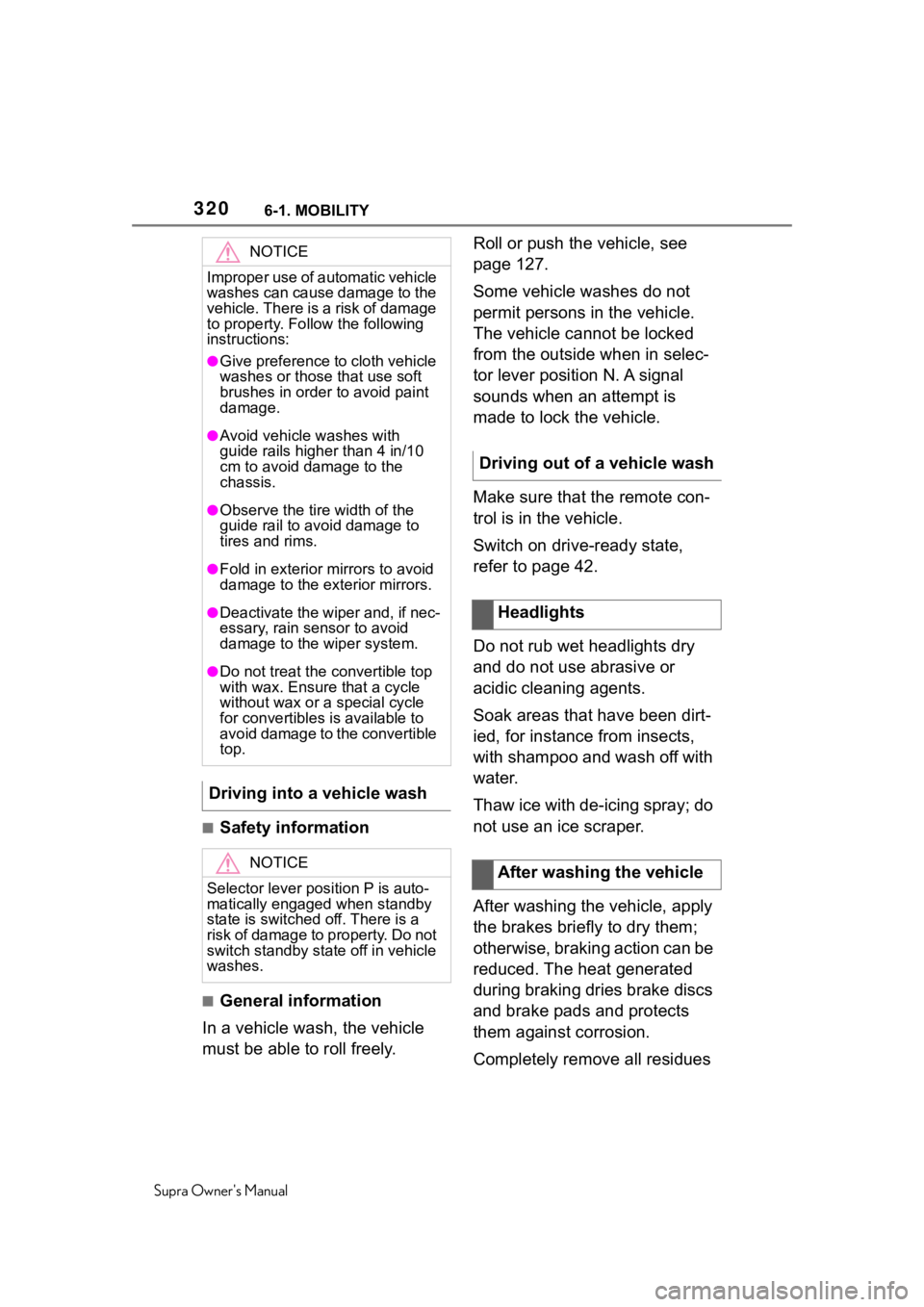
3206-1. MOBILITY
Supra Owner's Manual
■Safety information
■General information
In a vehicle wash, the vehicle
must be able to roll freely. Roll or push the vehicle, see
page 127.
Some vehicle washes do not
permit persons in the vehicle.
The vehicle cannot be locked
from the outside when in selec-
tor lever position N. A signal
sounds when an attempt is
made to lock the vehicle.
Make sure that the remote con-
trol is in the vehicle.
Switch on drive-ready state,
refer to page 42.
Do not rub wet headlights dry
and do not use abrasive or
acidic cleaning agents.
Soak areas that have been dirt-
ied, for instance from insects,
with shampoo and wash off with
water.
Thaw ice with de-icing spray; do
not use an ice scraper.
After washing the vehicle, apply
the brakes briefly to dry them;
otherwise, braking action can be
reduced. The heat generated
during braking dries brake discs
and brake pads and protects
them against corrosion.
Completely remove all residues
NOTICE
Improper use of automatic vehicle
washes can cause damage to the
vehicle. There is a risk of damage
to property. Fo
llow the following
instructions:
●Give preference to cloth vehicle
washes or those that use soft
brushes in order to avoid paint
damage.
●Avoid vehicle washes with
guide rails higher than 4 in/10
cm to avoid damage to the
chassis.
●Observe the tire width of the
guide rail to avoid damage to
tires and rims.
●Fold in exterior mirrors to avoid
damage to the exterior mirrors.
●Deactivate the wiper and, if nec-
essary, rain sensor to avoid
damage to the wiper system.
●Do not treat the convertible top
with wax. Ensure that a cycle
without wax or a special cycle
for convertibles is available to
avoid damage to the convertible
top.
Driving into a vehicle wash
NOTICE
Selector lever position P is auto-
matically engaged when standby
state is switched off. There is a
risk of damage to property. Do not
switch standby state off in vehicle
washes.
Driving out of a vehicle wash
Headlights
After washing the vehicle